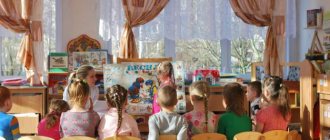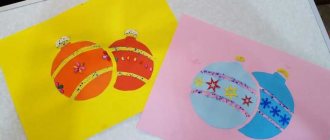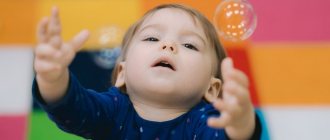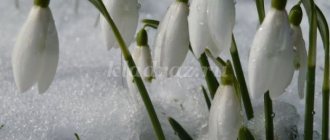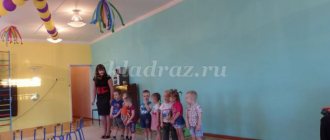Abstract “Spring has come to visit us” in an early age group
Summary of an integrated lesson in an early age group “Spring has come to visit us!”
Goal: To promote the development of children’s cognitive activity, enrich their ideas about spring (changes in nature), and activate vocabulary on the topic.
Educational areas: “Socio-communicative development”, “Cognitive development”, “Speech development”, “Physical development”.
Tasks:
1. Educational:
to form children’s ability for dialogical speech; learn to answer questions in words and sentences consisting of 3-4 words; enrich and activate vocabulary on the topic
2. Developmental:
teach to listen carefully and observe, when observing, to highlight the most striking, characteristic features of changes in nature
3. Educational:
cultivate a caring attitude towards the surrounding nature, trees, flowers.
(Children sit on chairs) Presenter: Guys, look how many guests have come to us, let's say hello to them. Hello! (Music sounds, spring enters) Spring: Hello, guys! Spring has come to visit you, I bring you my warmth, So that everything around you blooms, So that the leaves bloom, The birds sing. Guys, I want to invite you to visit me in the spring forest. Do you agree? Children: Yes Spring: But in order to go on a journey, we need to say the magic words. All the children gathered in a circle, you are my friend, and I am your friend, let’s hold hands tightly and smile at each other. Let's smile at each other, twirl, spin, and we find ourselves in the forest. Here we are in the forest. Why can't you see the sun today? Where did the sun hide? Let's look for him. Children: Behind the cloud. Spring: What color is the cloud? Children: Blue. Spring: How do we drive away the cloud? Children: Let's blow on it. (Breathing exercise) Spring: Let's blow on one shoulder, let's blow on the other, let's blow on the tummy like a tube in our mouth, let's blow on a cloud, let the cloud fly away. So our cloud flew away. What kind of sun has become now? Children: Cheerful, warm, radiant Spring: What color is the sun? Children: Yellow. Spring: Guys, do you know a poem about the sun? Tell the sun a poem. (Poem about the sun) Spring: Guys, the sun warmed the snow and it melted. A puddle has appeared, look what it is? (Pointing to the blue rag on the floor) Children: Puddle. Spring: What kind of puddle? Big or small? Children: Can I jump over it? Children: No. Spring: That's right, we'll walk through it on the pebbles, here they are. How many pebbles? Children: A lot Spring: We pass one after another, carefully. We don’t stand in a puddle, otherwise you might get your feet wet and get sick. Well done, crossed the puddle. And who else is hiding from us? Children: Bunny. Spring: Guys, the bunny is shaking all over, he was scared of us. Pet the bunny so that he calms down and stops being afraid of us. Tell me about the bunny, what kind of bunny? (Children pet the bunny and talk about him) Children: Gray, fluffy. Spring: What kind of bunny ears does it have? Long or short? Children: Long. Spring: What about the ponytail? Children: Short. Spring: Guys, look, the bunny has stopped shaking and wants to play with us.
P/i “The gray bunny is sitting”
Spring: Well done, how fun you played, let's let the bunny go. Guys, not all the snow in the forest has melted yet, there is still a large snowdrift. Oh, who's moving there? Let's see who it is? Children: Bear. Spring: Oh, I slept for a long time. The bear is bored, let's play with him?
P/i "Bear"
Spring: Well done! We cheered up the bear, let him sit and look at us. Look what we have growing here? Children: Trees. Spring: What is this on the trees? Children: Leaves. Spring: What color are the leaves? Children: Green. Spring: In spring, the sun shines brighter and warmer, and this causes green leaves to appear on the trees. Spring: Guys, it’s late, it’s time for you and me to return to kindergarten. Over the hummocks, over the stumps, be careful not to fall, jump - jump, jump - jump! We turned around, turned around, and returned home to our own kindergarten. Well, guys, did you like our trip to the spring forest? Children: Yes. Spring: Who did you meet in the forest? (Children's answers) Spring: Guys, you walked with me and played with me. I have prepared gifts for you. Bright, multi-colored balls. What color are the balls? (Children's answers) But it's time to say goodbye, and for me to return to the forest.
Lesson summary “Spring is Red” (nursery group)
Nellya Kozlovtseva
Lesson summary “Spring is Red” (nursery group)
Subject:
"Spring"
Target:
promote the development of children's cognitive activity, enrich their ideas about spring natural phenomena, and enhance speech development.
Tasks:
Educational:
to form in children an idea of seasonal changes in nature: it has become warm, the sun is shining brightly, buds are swelling on the trees, leaves, grass, and the first flowers are appearing; Learn to perceive the image of spring through artistic and musical expression.
Developmental: develop coherent speech, attention to observing spring phenomena; develop the ability to imitate a given image, develop imagination, creativity and fine motor skills.
Educational: to cultivate the ability to see the beauty of nature, to cultivate interest and curiosity for nature; to cultivate the sound culture of speech: correctly pronounce the vowel sound [u], correctly pronounce onomatopoeia -kap - kap;
Integration of educational areas:
cognitive development, social and communicative development, physical development, speech development, artistic and aesthetic development.
Leading educational area:
cognitive development
Form of activity:
joint activities of adults and children.
Leisure participants:
children of the first younger group (2-3 years old, teacher and junior teacher.
Materials and equipment: image of a steam locomotive, model of a “cloud” and “sun”; carousel hoop; clothespins, flowers mockup, basket.
Preliminary work:
• Conversations, examination of illustrations: “Spring”, “Signs of Spring”.
• Games: “Dress the Katya doll for a walk,” “What’s extra?”
• Experimental research activities: implementation of the “Droplet” project (studying the properties of water, snow, ice).
• Learning finger gymnastics, “Radiant Sun” exercises.
• Compiling a descriptive story based on the painting “Spring” (from the “Seasons” series). Observing changes in nature.
Expected results:
He can guess the season based on a verbal description, name the signs of spring, answer questions on the topic, and select objects for their intended purpose.
Progress of the lesson:
Introductory part.
(A teacher in a Spring costume comes out to the group and addresses the children)
Educator: Hello, guys! Do you know what time of year it is? (Spring).
That's right, spring, spring-red - that's me. I'm so glad you recognized me. For a long time I walked to you through winter blizzards, cold winds and snowdrifts. Let's talk about the time of year - spring! Tell me, does the snow melt in the spring? Are there puddles? Are the buds swelling? Are the birds flying? In spring, the first flowers and grass appear? Is it raining and the sun is shining brightly? Guys, let's call Sunny?
(Call "Sun")
The sun is clear, dress up, (claps on the shoulders, cross your arms over your chest)
Red sun, show yourself (clap your hands)
Put on the scarlet dress, (clap your knees)
Give us a red day. (clapping overhead)
(The sun sets)
Sun:
Hello guys! I am very glad to meet you. You called me so loudly that I could not help but come to you.
Main part.
Educator:
Guys, look at our Sunshine? Warm, light, round? Do you know what the sun is for? It warms everything on the earth, helps flowers, trees and children grow. Our spring sun is gentle, because spring has come. Let's play with the sun?
(Game “Solar Carousel”)
Educator:
Ray up, ray down,
Smile at the children as a ray of rays,
Look to the right, to the left,
Go around the sun.
(Children take hold of the ray ribbons and move in a circle to the song. At the end of the song they stop)
Educator:
Did you like the game? Let's make a sunshine together?
(Construction from clothespins “Sun”)
(Children pinch clothespins along the edge of the model of the sun (cloud))
Educator:
Then we’ll make a cloud.
Educator: Oh, we didn’t even have time to make a cloud when it started to rain!
(Physical school)
Rain, rain, little by little,
Drip and drip onto your palm. (tapping your finger on your palm)
I'm jumping through puddles
And now our boots (we put the boots on our feet and start walking through the “puddles”)
We put it on the legs.
Educator:
Tap your fingers on the table as if droplets are falling to the ground. Now it’s raining heavily and our droplets are knocking hard and fast. Now the rain has begun to weaken, we knock quietly, rarely. When the last drop has fallen, tap it once with your finger. The sun has shone again and is calling us into the forest. The first flowers grew in the forest. Let's go, admire them and collect them in a basket, and then bring them to the kindergarten.
Educator: Oh, what are we going to drive? Maybe on a steam locomotive? Look, we have it (Shows a model of a steam locomotive).
Go!
Educator:
Guys, how is the locomotive humming?
(oo-oo-oo)
Let's all sound like a steam locomotive together: ooh-ooh.
Educator:
Here is our train coming,
The wheels are knocking
And on our train
The guys are sitting
Chu-chu-chu, chu-chu-chu!
(The locomotive approaches a clearing with flowers)
Educator:
Guys, admire the first spring flowers. How beautiful they are! Green grass will soon appear, and the first leaves will appear on the trees. The birds are singing loudly. This is what a beautiful spring is!
Educator: Look how many flowers there are! Oh, look there’s a basket. Let's collect flowers in a basket.
(Children collect flowers in a basket)
Final part.
Educator: What great fellows you all are! Our journey has now ended. It's time to go back. We all get on the locomotive and go back.
Sunny: Well, it’s time for me to return to my place too. Goodbye friends!
MAGAZINE Preschooler.RF
Project in the first junior group “Spring”Project goal: To introduce children to the characteristic signs of spring, to teach them to establish cause-and-effect relationships.
Tasks:
- Expand the understanding of seasonal changes in nature in spring, the simplest relationships.
- Activate the dictionary on the topic “Spring” .
- Foster a caring attitude towards the natural environment.
- Develop fine motor skills of the hand and mental processes.
Project participants: Children aged 2-3 years, teacher Olga Yuryevna Romanova.
Type of project: cognitive - speech.
Visual methods: looking at a picture, showing illustrations, educational experimental experience “Planting onions.”
Verbal methods and techniques: teacher’s story, questions for children, artistic expression.
Practical and game methods: exercises for the development of speech breathing, outdoor games; “Breeze” , “Spring” , round dance “Vesnyanka” , physical education, didactic games, finger gymnastics.
Material and equipment: flannelgraph and images for laying out on it: the sun, a tree without leaves, leaves, flowers, birds, for an experiment with snow: snow on a metal tray, earth, bulb seeds, a basin of water, paper boats, the didactic game “Which what color is the flower? .
Expected results: Be able to guess the season using a verbal description, name the signs of spring, answer questions on the topic, select objects for their intended purpose, master the basic movements when performing finger gymnastics, take part in outdoor games. Take part in productive activities (sculpting leaves on a tree), painting “Crybaby Icicles” with a brush.
Integration of educational areas: Social and communicative development, cognitive development, speech development, artistic and aesthetic development, physical development.
Brief summary of the project:
- Cognitive development. GCD "Hello Spring" .
- Speech development. GCD "Spring Flowers"
- Artistic and aesthetic development.
- GCD drawing on the theme “Crybaby Icicles” .
- GCD modeling on the theme “Leaves on the trees” .
Physical development. Outdoor game “Spring” , physical education lessons; “Stream” , “Our scarlet flowers” , “Vesnyanka” , “Oh stream, whose are you, whose?” .
Musical development. Song "Rain - rain drip and drip!" , round dance "Vesnyanka" .
Social and communicative development. Didactic games; “Find a petal for each flower” , “Make a picture - flowers from two parts”
Working with parents: Exhibition of joint works “Spring has come”
| Next > |
Comprehensive thematic planning in the first junior group on the topic "Spring"
1. Conversations:"Spring came!"
Based on the painting “Spring has come”, “The rooks have arrived”, “Who are the insects?”, “Caution, puddle!”.
2.Observations:
Observation of spring changes in nature (it has become warmer, the length of the day has increased, the snow is actively melting); Observations of birds, animals, plants and other objects of living nature found in the immediate environment (pay attention, examine, examine, listen, name, convey features by voice, in motion); drawing children's attention to unusual phenomena and objects (flowering plants, a ray of sunshine, the shine of a puddle, etc.);
— “Observation of the first flowers”
— “Observing people’s clothes”, etc.
3. Didactic games and exercises:
“Recognize by voice”, “Who should I give what to”, “When does this happen?”, “Name it correctly”, “Spring has come!”, “What does it sound like?”, “Clothing store”, “What’s extra?”, “What kind of icicles?” ?”, “Drip-drip”, “What happens in spring”, “Find out and name”, “What has changed?”
4. Free communication (Situational conversations):
“How can you play outside in the spring?”
"The birds have flown"
“How to dress in spring”
“What’s the weather like in the morning when you go to kindergarten?”
“Is it possible to walk through puddles?”; situational conversations about keeping clothes clean while walking (avoid puddles, shake off wet sand from clothes, etc.). Conversations to enrich children’s understanding of the main sources of vitamins that improve health in the spring;
5. Finger games:
“Spring”, “First flowers”, “Sun”, “Rain”, “Birds”, “Butterfly”, “Flower”, “A squirrel is sitting on a cart”, “We shared an orange”,
6. Research activities:
“Shine the sun…”, “Multi-colored glass”, “Shadow”, “Boat”, “Experience in identifying the properties of sun rays” (walk)
8. Construction Games:
“Gate and fence for a bird”, “Multi-storey building”, “Ladder”.
9. Reading:
“Sunshine”, “Oh, you little bunny”, “Our ducks in the morning”, “Cockerel, cockerel”, A. Barto “Boat”; A. Pleshcheev “Spring”, “Rural Song”; fairy tale “Visiting the Sun”, “The Cockerel and the Bean Seed”; G. Lagzdyn “Cockerel”; N. Pikulev “Fox Tail”; A. Vvedensky “Mouse”; V. Bianchi “The Fox and the Mouse”; L. Tolstoy “The cat slept on the roof”; G. Ball "Yellow"; K. Chukovsky “Cock-fly”, “Cockroach”; song “Ladybug”; K. Belmont “2Mosquitoes-Makariki”; L.Modzalevsky “Moth”; E. Moshkovskaya “grasshopper”; learning “Ant”, “Bug Song”, “About a Butterfly”
10.Game-based learning situations:
“Katya the doll is preparing dinner”, “We are going to visit on the bus”.
11. Theatrical games (imitation games):
“Boats are sailing”, “Magic pipe”, “Construction site”, “Water, wash my face”, “Zayushkina’s hut”
11. Outdoor games:
“Sunshine and Rain”, “Get Through the Gate”, “Through the Stream”, “Sparrows and the Car”, “Birds Are Flying”, “Where Did You Knock?”, “Monkeys”
12. Life safety:
“Our friends and enemies”, “Dogs can be biters”, Listening to the song “Forbidden - Permitted”, “How to take care of your health”.
13. Review of albums:
“Spring”, “Migratory Birds”, “Insects”, “Animals”.
14. Physics:
“Wind”, “Hedgehog”.
15. Unlearning
songs and round dances about spring.
